Modak Recipe – Handmade & With Mould
With the arrival of Ganesh Chaturthi in India, the most cherished sweet offered to Bhagwan Ganesha is the Modak. The classic Maharashtrian Modak recipe usually refers to Ukadiche Modak – steamed rice flour dumplings stuffed with a sweet coconut and jaggery mixture, lightly flavored with cardamom and nutmeg. Soft, delicate, and aromatic, these sweet dumplings are made as prasad during the festival. In this recipe, I share two methods of making them – handmade and with mould.
Modak – A Traditional Sweet
The traditional steamed Modak is a sweet dumpling with an outer rice flour dough and a coconut-jaggery stuffing. These dumplings are also known as Ukadiche Modak in Marathi language.
It is a popular sweet that is commonly prepared and enjoyed in India, especially during the Hindu festival of Ganesh Chaturthi.
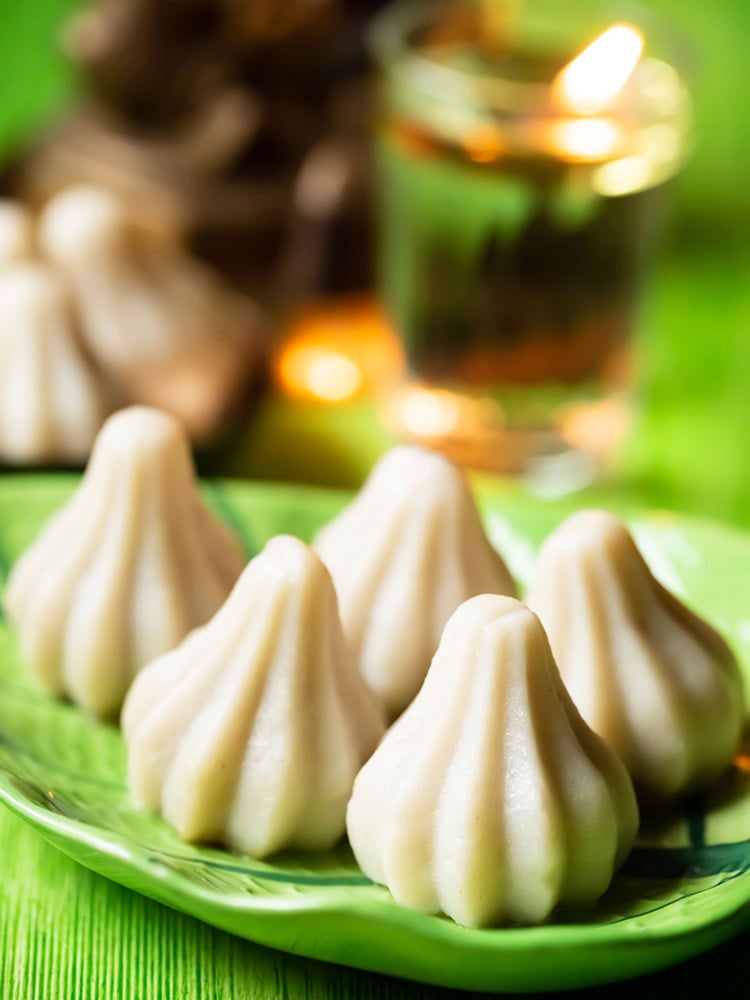
Like I mentioned in the beginning, it is considered Bhagwan Ganesha’s favorite sweet and is often offered as prasad (offering) during prayers and rituals dedicated to him.
Table of Contents
Here I share the classic Modak Recipe that belongs to the cuisine of Maharashtra. It has an outer rice flour dough that is stuffed with a simple, yet delectable coconut-jaggery filling. Later, the sweets are steamed and then savored or served to Ganesha.
The word ukadiche means “that which is steamed” or simply “steamed.” Ukad also refers to steamed rice flour dough. So in simple English, this variety of Modak means steamed modak.
The shape of a Modak is quite distinctive and resembles a small, inverted rice cone with pleats or patterns. Preparing this sweet requires some skill in shaping the dough and is often considered an art form in Indian cooking.
To give the fluted shape with fingers, some practice and experience is required. I prefer to use modak moulds as I find shaping with them quicker than doing it by hand.
Many shops begin to sell the moulds before Ganesh Chaturthi, and you can even buy them online. If you are a beginner, you can make the half-moon shape or use the moulds.
Sometimes, the stuffing may also include flavorings like cardamom, nutmeg, saffron, and chopped nuts, depending on regional variations and personal preferences.
Making of Ukadiche Modak Recipe
Ukadiche Modak is a specific variety that originates from Maharashtra, particularly popular in the Konkan region, and is often prepared as an offering during Ganesh Chaturthi. The two most important elements of this recipe are:
- Dough: Made with rice flour, hot water, and a pinch of salt to create a smooth, pliable dough. It is kneaded well so that it’s soft and easy to work with.
- Filling: Traditionally made with fresh coconut and jaggery, cooked together in a bit of ghee and lightly flavored until it thickens into a sweet aromatic mixture.
Shaping Modak
Next comes shaping the Modak. A small portion of the dough is flattened into a circle, the sweetened coconut filling is placed in the center, and the edges are carefully folded and pleated to form a conical or pyramid-like shape. The top is often pinched to give it a design.
Shaping with hands requires some skill and practice, but you can also use readymade moulds for a neater and quicker result. In this post, I have demonstrated both methods – handmade and using a mould.
Modak can be shaped in many ways. You can make them with the fluted petal shape or even in the shape of a half-moon, similar to a Karanji or Gujiya.
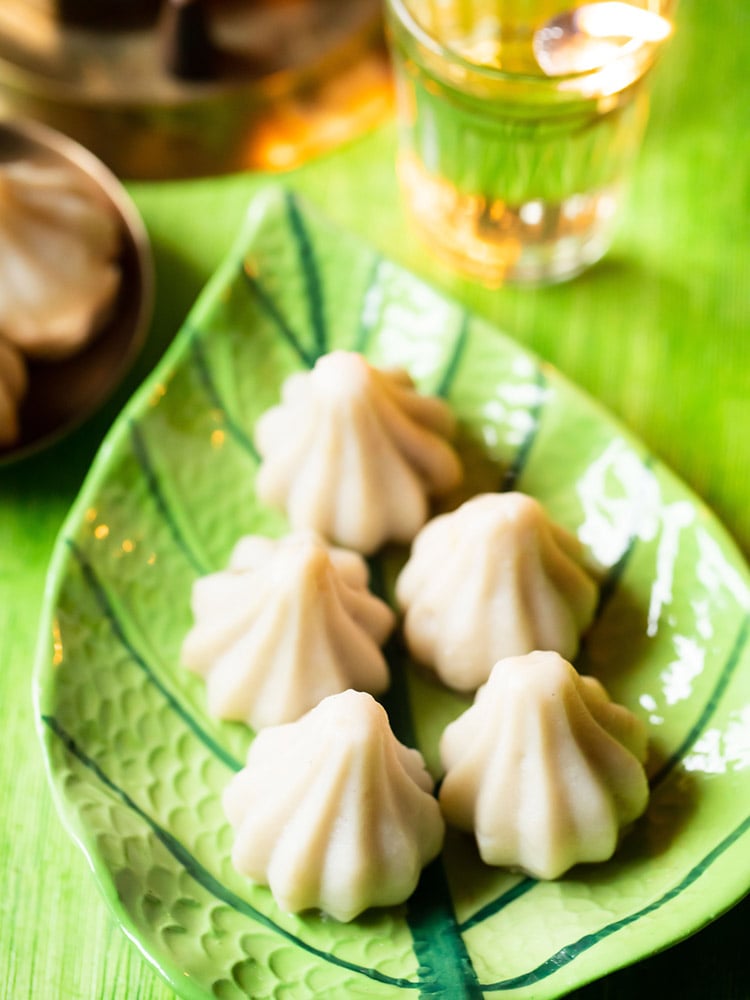
Steaming Modak
Finally, the modaks are steamed until the outer covering becomes soft and slightly translucent. This usually takes about 10 to 15 minutes, depending on whether you use a pan, pressure cooker, or Instant Pot.
In this gluten-free and vegetarian recipe, you’ll be able to prepare this delicious sweet in two ways – with a mould and without a mould (handmade).
If you are looking to make more festive sweets, do check my Ganesh Chaturthi Recipes collection for more ideas.
How to Make Modak (Step by Step)
To make modak, we begin by preparing the sweet coconut and jaggery stuffing. This mixture forms the inner filling of the steamed modak. It is important to make the stuffing first so that it has time to cool down before shaping the modak.
Make Sweet Stuffing
1. Chop the jaggery and keep aside. Also, grate the coconut and keep aside. You will need 1 cup (200 grams) jaggery and 1 cup (100 grams) fresh grated coconut.
If you do not have access to fresh coconut, then use frozen coconut or desiccated coconut.
For desiccated coconut, use fine grates or fine shreds. Is using frozen coconut, thaw it prior to cooking.
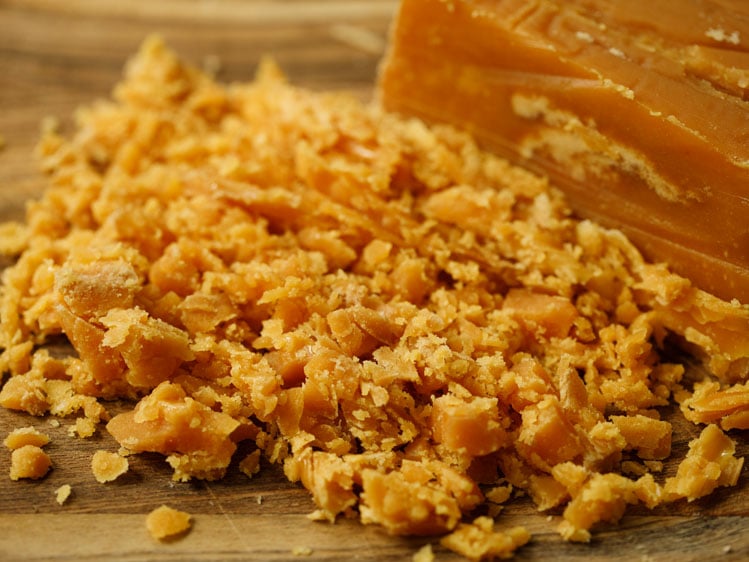
2. Heat ghee in a pan. Add ½ teaspoon poppy seeds. Keep heat to a low. Fry for some seconds till the poppy seeds start crackling.
Note that poppy seeds are optional and can be given a miss.
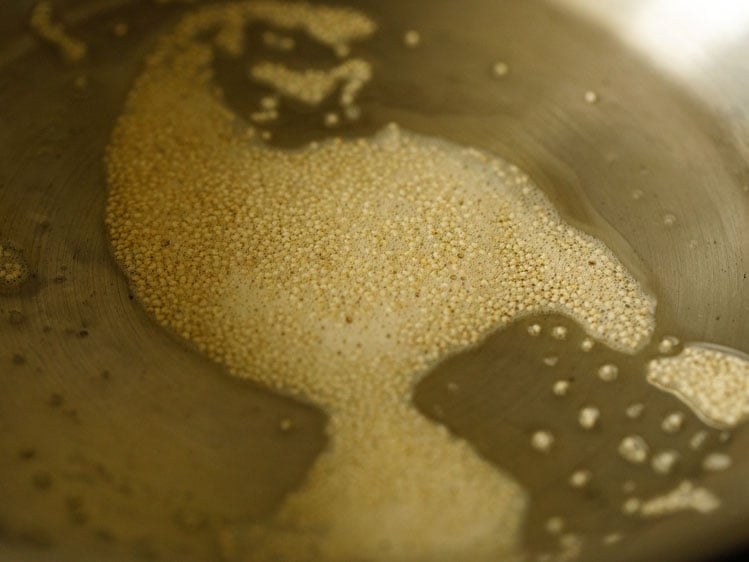
3. Then, add the fresh coconut, chopped jaggery, ¼ teaspoon grated nutmeg (or nutmeg powder) and 1 teaspoon green cardamom powder.
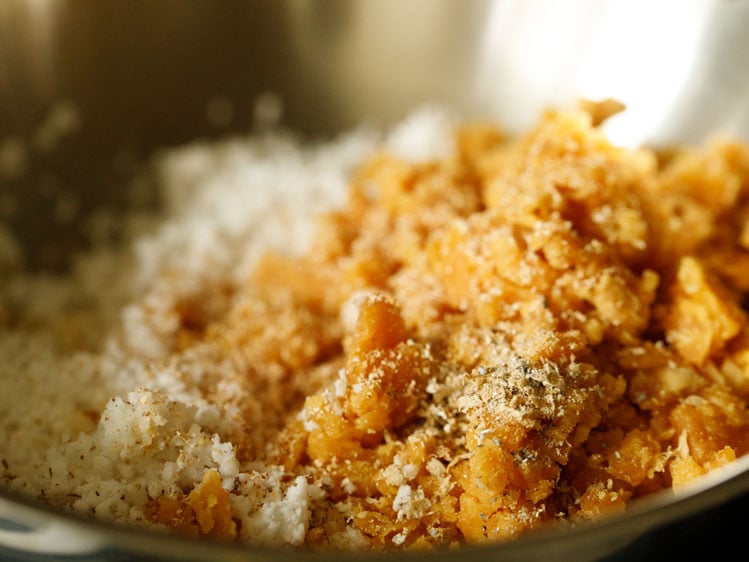
4. Mix well and cook this coconut-jaggery mixture on low heat.
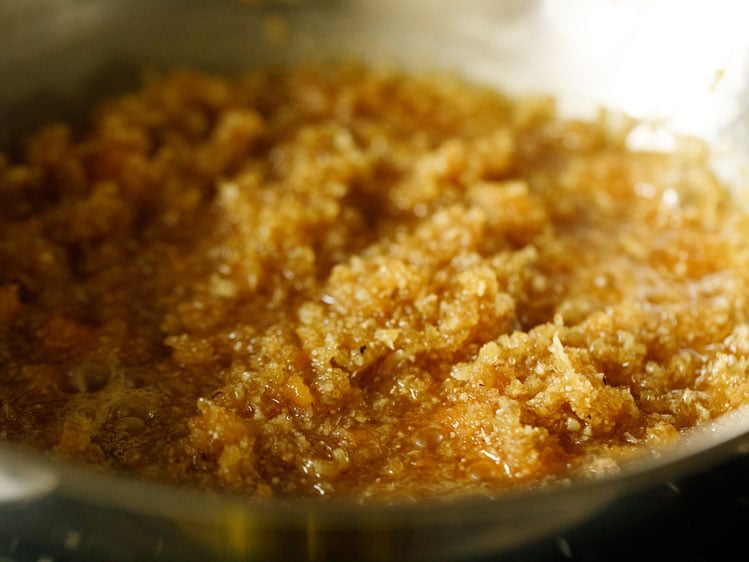
5. The jaggery will melt first. Cook on low heat and stir often.
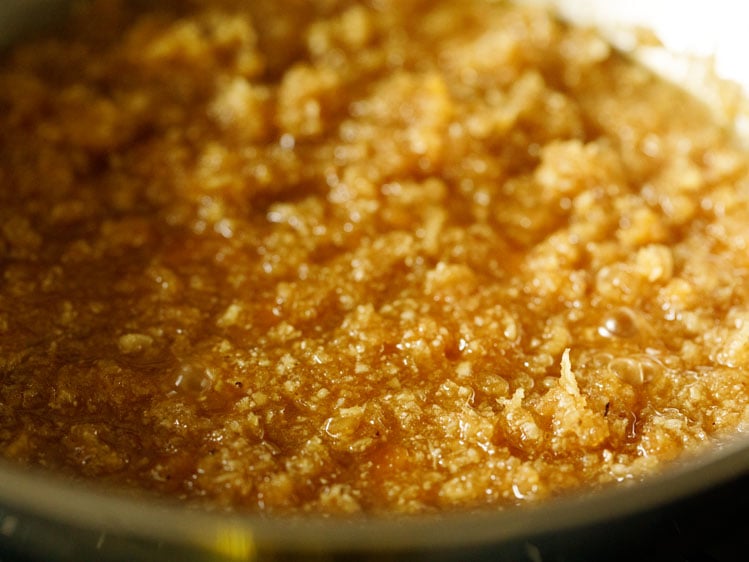
6. Stirring often, cook this mixture for about 7 to 9 minutes or till the moisture from the jaggery begins to dry. Turn off the heat.
Don’t overcook as the jaggery then hardens. Keep this coconut-jaggery filling aside and let it cool completely. On cooling, the mixture will thicken more.
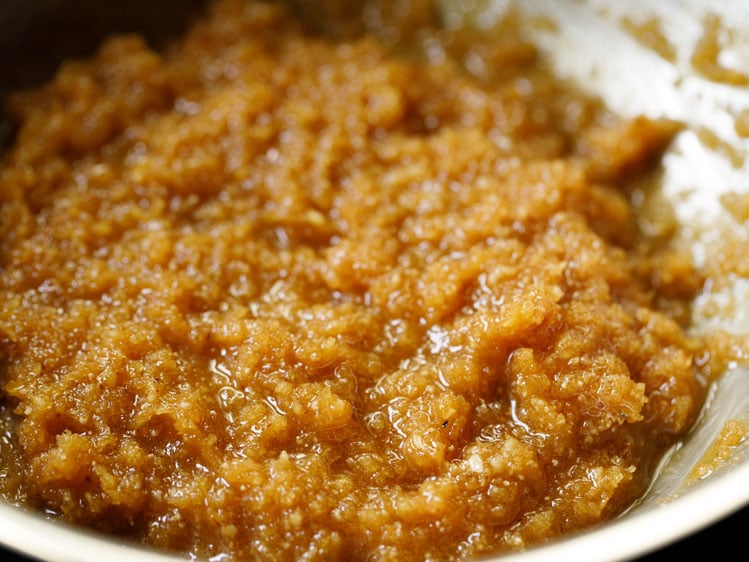
7. The following is an optional step. You can add 1 tablespoon rice flour to this mixture and mix well.
The rice flour helps to absorb moisture if any from the sweet stuffing. Keep the stuffing aside to cool.
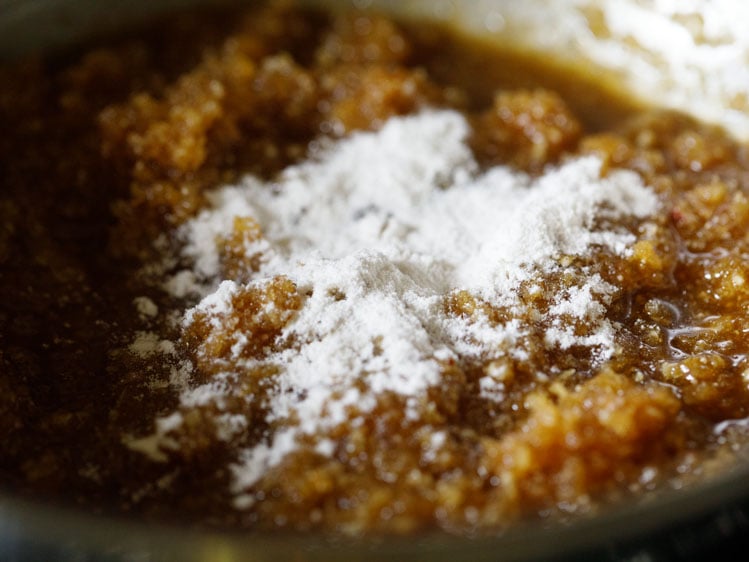
Make Rice Flour Dough
8. In a pan, add 1.5 cups water, ¼ teaspoon oil or ghee and ¼ teaspoon salt. Keep it on the stovetop.
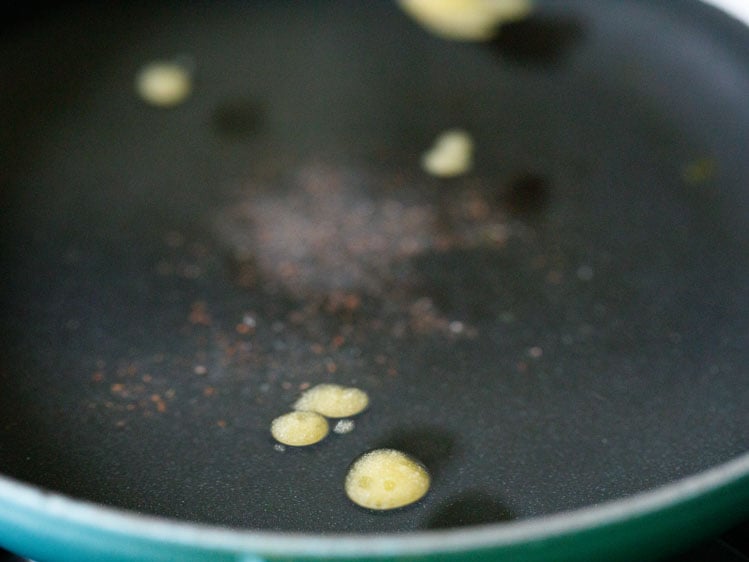
9. Let this mixture come to a boil.

10. Add 1 cup (150 grams) rice flour.
You can use Homemade Rice Flour or packaged flour. Make sure the rice flour is fresh and within its shelf period.
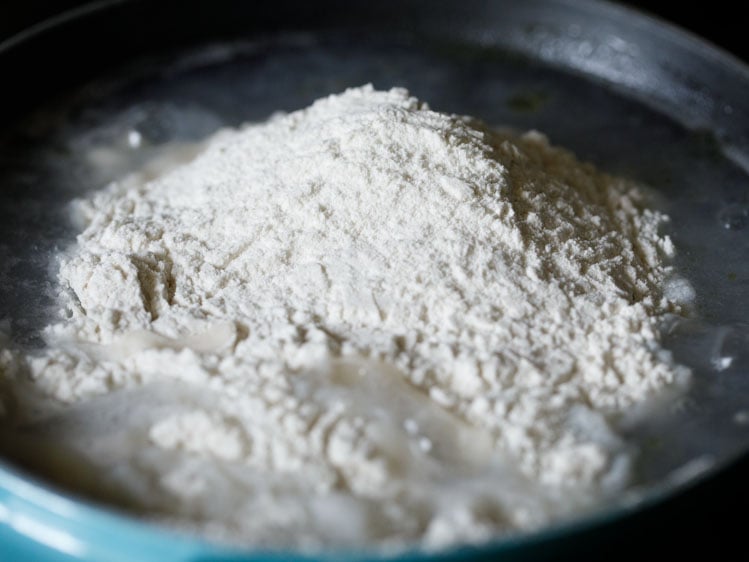
11. Quickly stir and mix the rice flour with the water.
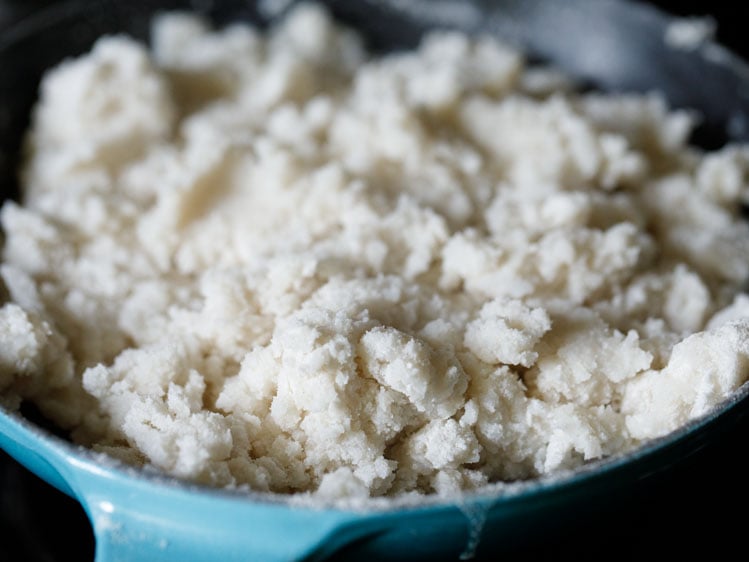
12. Stir till all the rice flour is mixed with the water. Turn off the heat. Remove the pan from the burner and keep on the workplace. Cover the pan with a lid for 4 to 5 minutes.
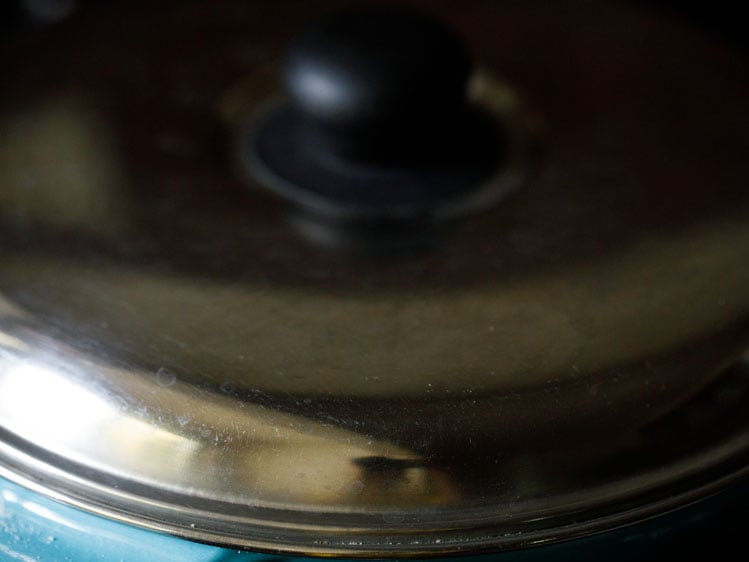
13. Now, take all the dough in a plate, thali or in a bowl. Gather the dough together and begin to knead it.
The dough will be hot when you begin to knead. So, spread some water on your palms and knead the dough. Knead the dough very well.
If you feel the dough looks dense or hard or dry, then add a few teaspoons of warm water and continue to knead.
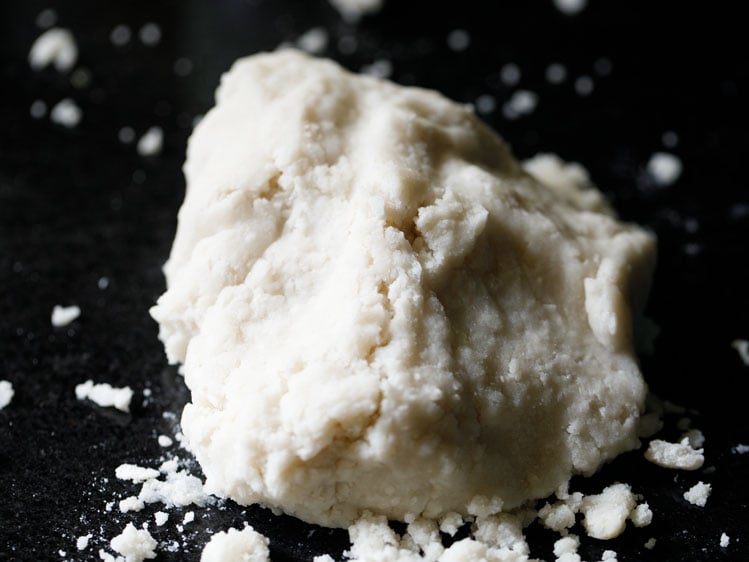
14. Knead to a smooth and soft dough without any lumps.
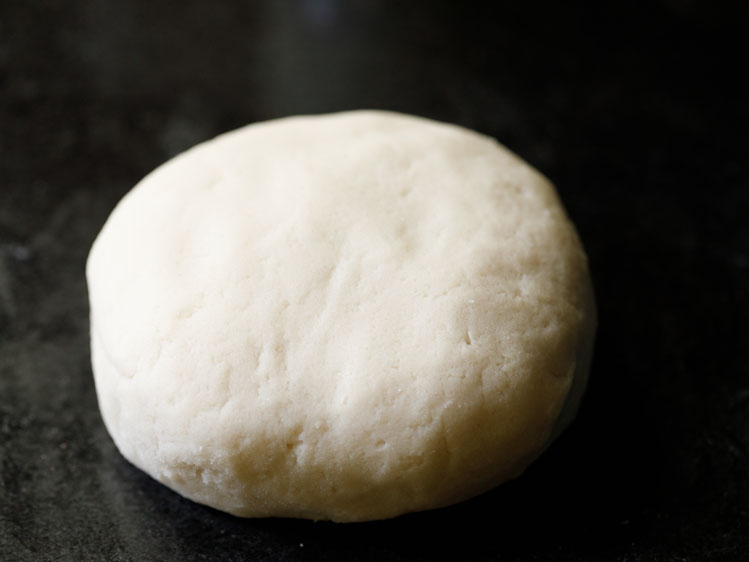
15. Make small balls from the dough. Roll the balls till smooth in your palms. You can also apply some water on your palms, while rolling the balls.
Keep the balls covered with a kitchen towel. The balls should not have cracks. They should be smooth in appearance.
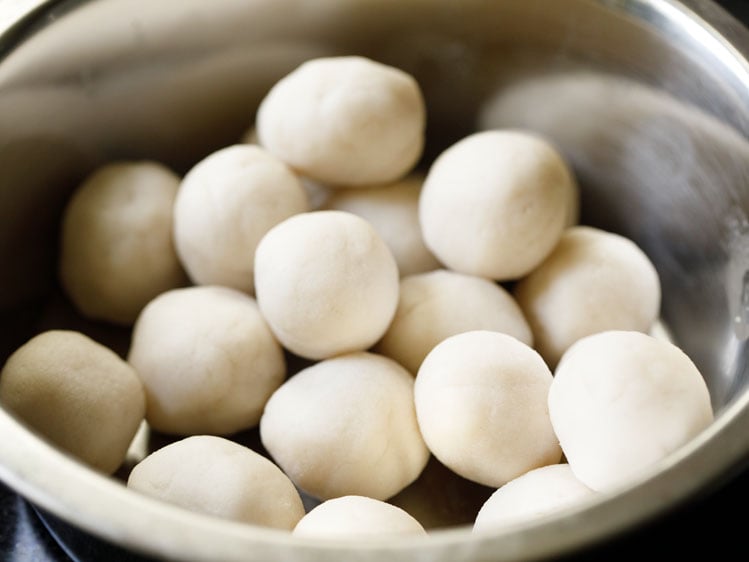
Shape Without Mould
16. Take a ball and flatten it with your fingers or on your palms, to a round disc or a shallow bowl shape to a medium thickness.
You can apply ghee or oil in your palms, while flattening. You can keep the edges slightly thin and the center can be thick.
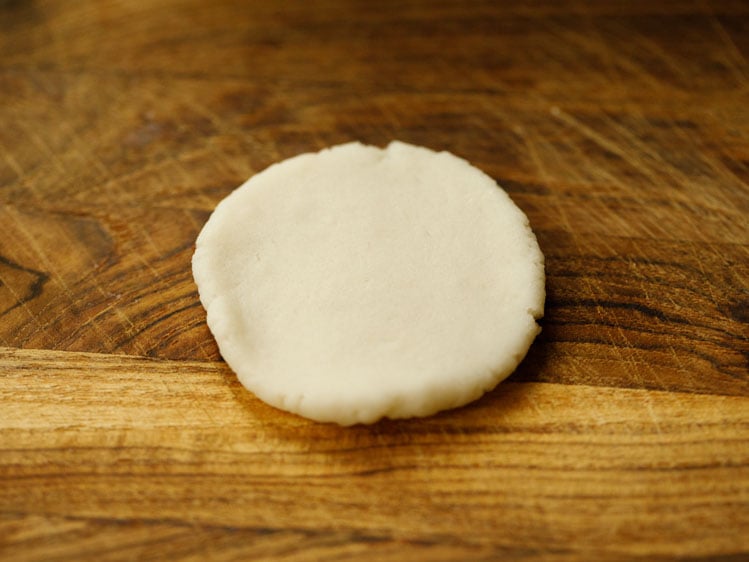
17. Place a few teaspoons of the prepared stuffing in the center.
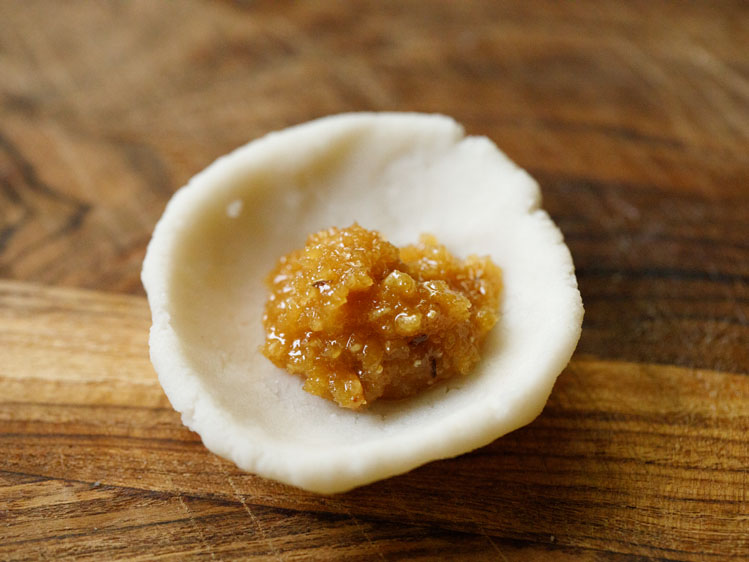
18. Press the edges as shown in the picture below. You can also press the edges first and then place the stuffing.
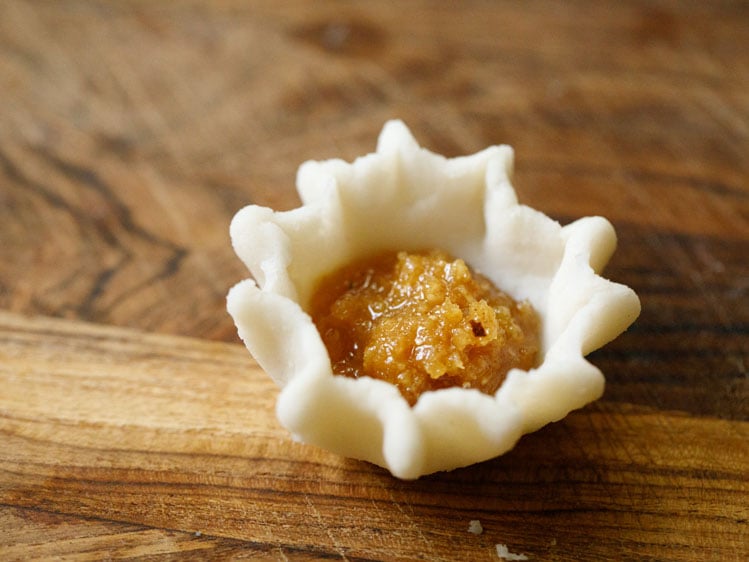
19. Bring together all the edges and join them. Remove the extra portion of the dough from the top, if any. Shape and taper the top of the Modak with your fingers.
You can also use ready moulds. They are usually available in shops and market some days before the Ganesh Chaturthi festival.
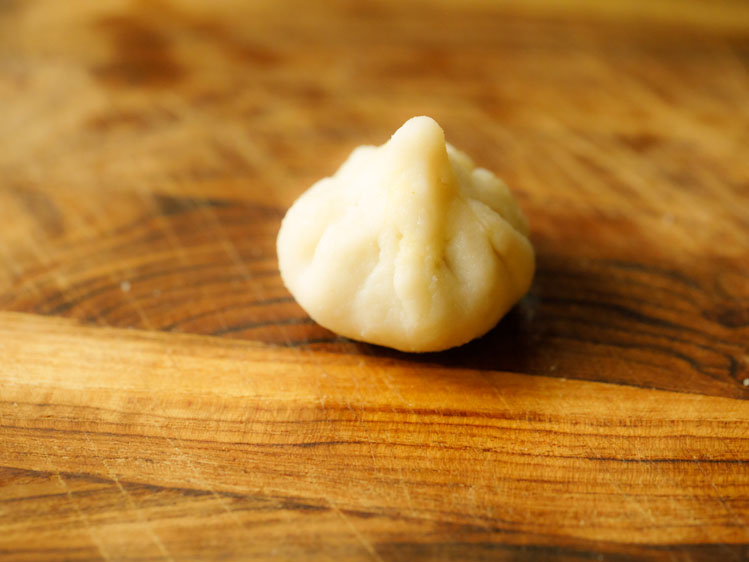
Shape Modak With Mould
20. Grease the mould with a bit of ghee or oil. Then, close or lock the mould.
Put the dough ball inside the mould and press it so that a space is made in the center. The rice dough will form a layer touching the walls of the mould.
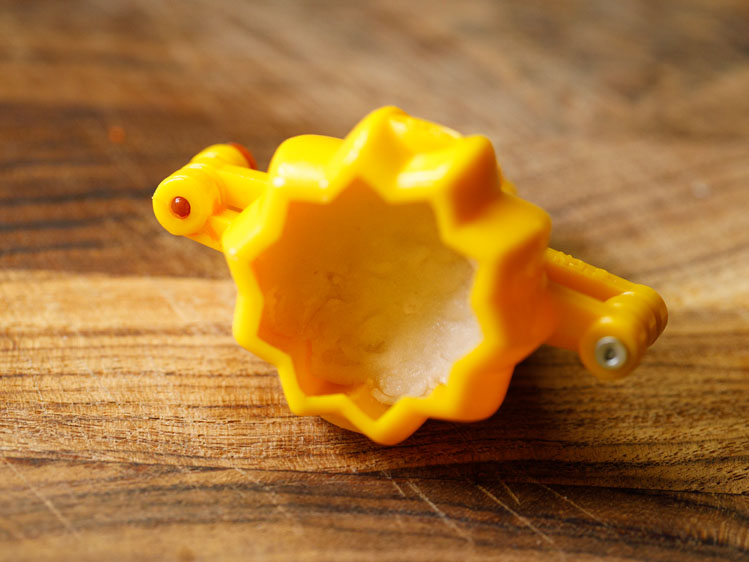
21. Place the sweet stuffing inside.
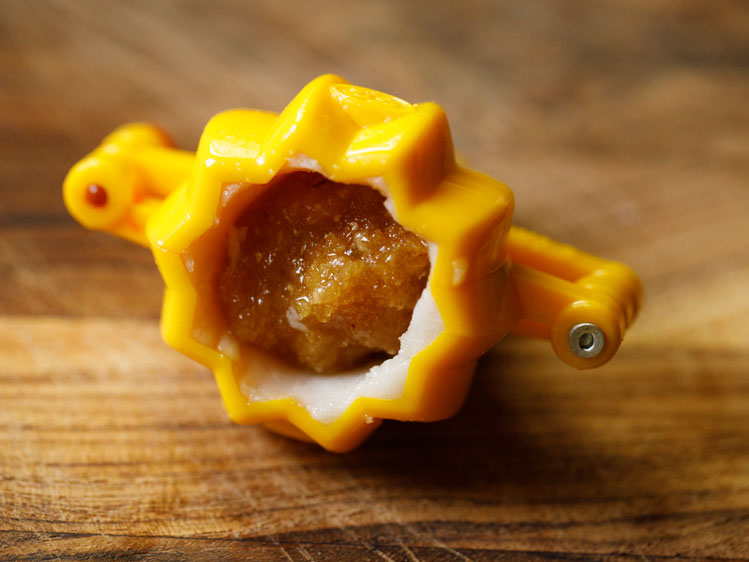
22. Cover the bottom with a small piece of dough. Press and smoothen it, sealing the Modak.
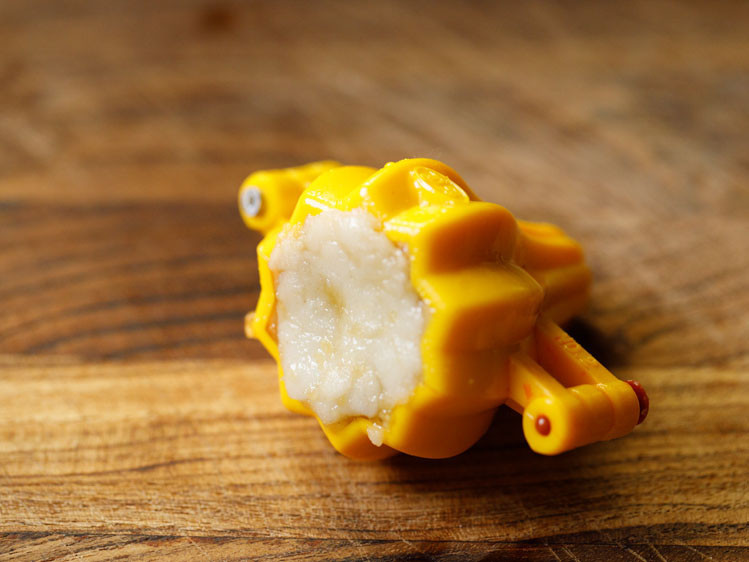
23. Open or unlock the mould. Remove the sweet gently from the mould. Shape all Modaks this way with mould.
Keep the shaped Modak covered with a napkin, so that the rice dough does not dry out.
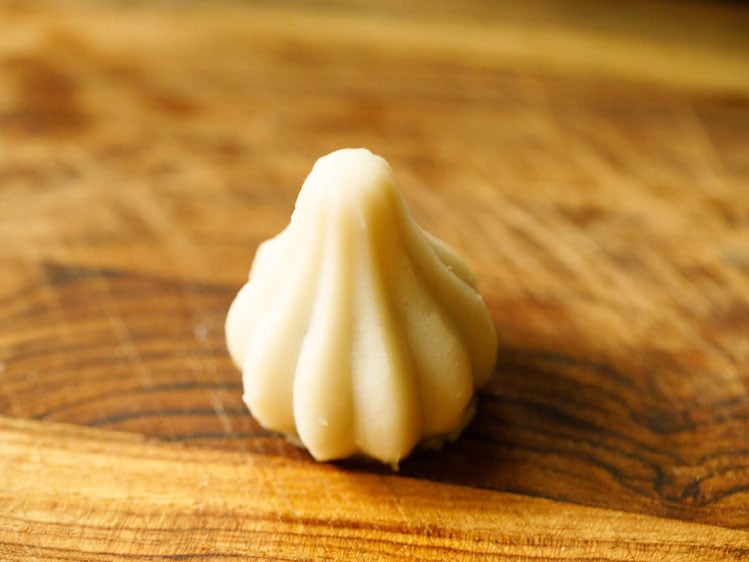
24. Make all the Modak this way. Brush or grease a pan with some oil or ghee.
The pan can also be lined with banana leaves or turmeric leaves. Place the shaped Modak in the greased pan with some space around them.
Remember to cover the shaped Modak with a moist muslin or cotton napkin before you begin to steam, so that they do not dry out.
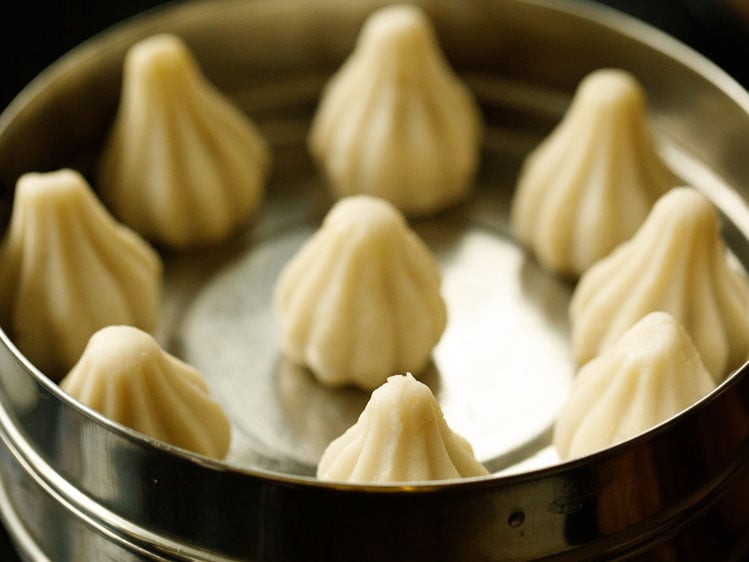
Assemble & Steam Modak
25. Take 2 to 2.5 cups water in a pot, pressure cooker or an Instant Pot steel insert. Place a trivet or a rack. Heat the water till starts to boil on a high heat.
For instant pot, use the sauté option and let the water begin to boil.
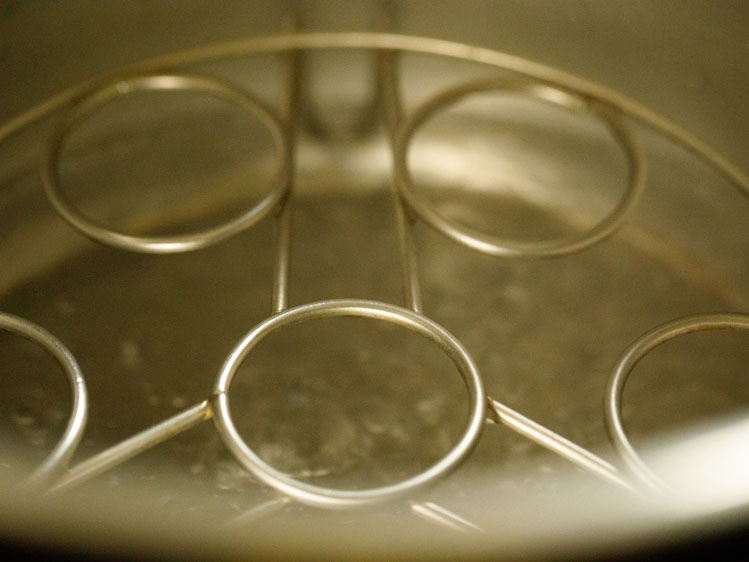
26. I have stacked 2 pans for steaming 16 Modaks. But you can also steam in separate batches.
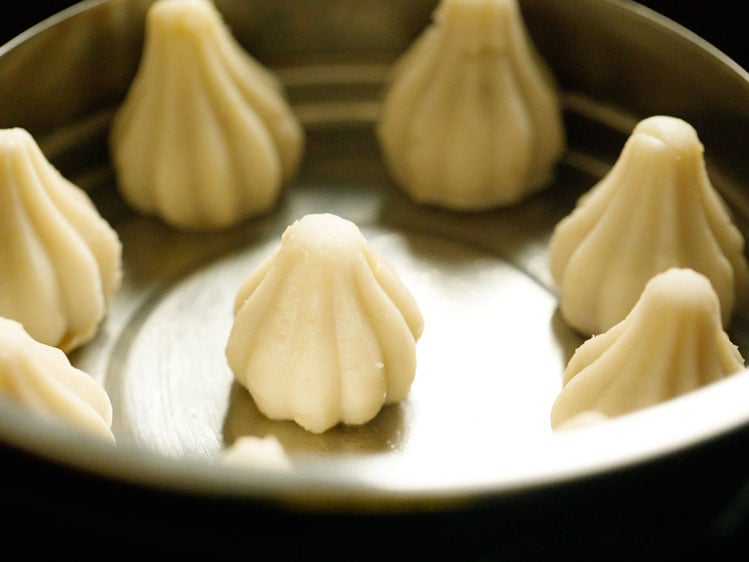
27. Cover the pan and steam on medium-low heat for 10 to 15 minutes. Once steamed, drizzle a few teaspoons on ghee on them, if you prefer.
The Modak should not feel sticky to touch when cooked perfectly. If they look or feel sticky, then steam them for a few minutes more.
On the Instant Pot, use the steam function on high pressure for steaming and keep the steam vent in venting position so that the steam releases while steaming.
Use a stop watch to set the time to 10 or 12 minutes. When the steaming is complete, lift the valve carefully to remove any pressure and then open the lid.
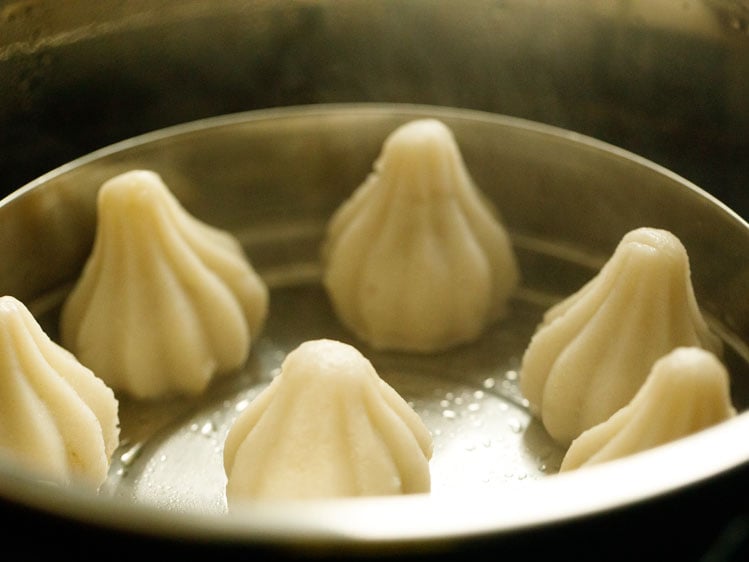
28. Ukadiche Modak is ready for offering Bhagwan Ganesha.
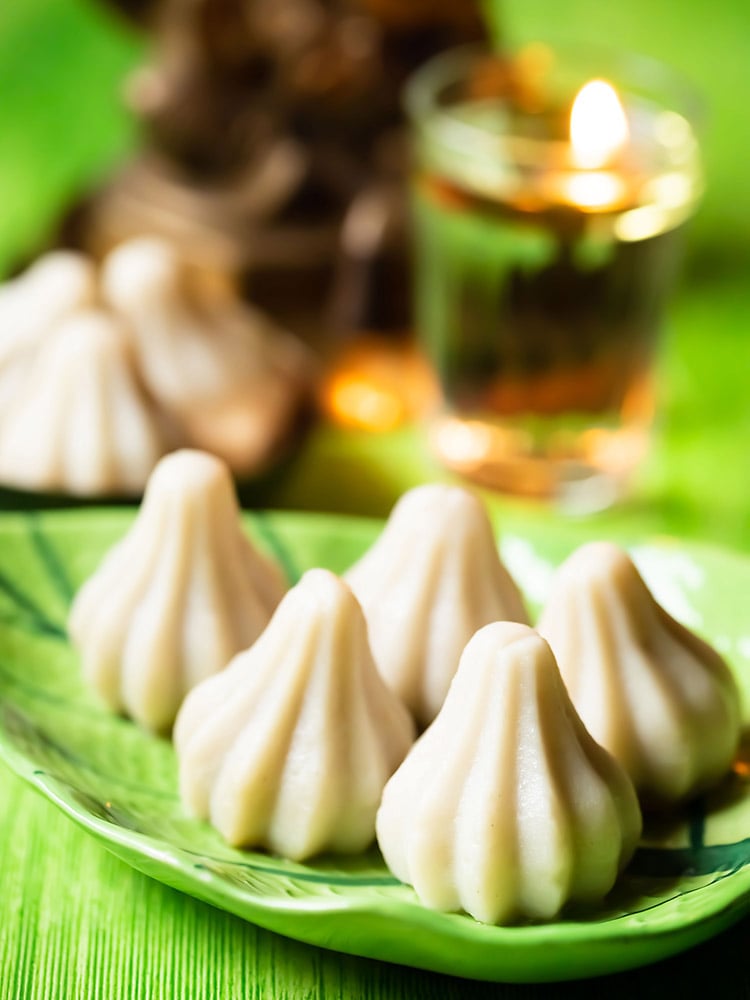
Note: If you are making the Modak Recipe as prasad or naivedyam, then refrain from tasting the stuffing or the dough.
When prepared with utmost care, love and devotion, this prasad will nourish everyone’s being, subtly. Use clean utensils and good quality ingredients and prepare them in a clean and hygienic manner.
Serving Suggestions For Every Occasion
Steamed modak can be served in different ways depending on the occasion — whether you’re offering it as naivedyam to Bhagwan Ganesha, sharing with family after a puja, or enjoying it casually as a homemade sweet. Here are simple and practical serving ideas for each.
Serving Modak as Naivedyam to Bhagwan Ganesha
- Number of Modaks: Traditionally, 21 modaks are offered to Bhagwan Ganesha. But you can offer any odd number as per your capacity (5, 7, 11, or 21).
- Serving Plate: Use a clean banana leaf or silver thali or a steel thali. Arrange the modaks in a neat circle or stack like a small pyramid.
- Accompaniments (Optional):
- A small bowl of panchamrit (mix of milk, curd, ghee, honey, and sugar)
- A piece of fresh fruit or some flowers (specifically Desi Red Hibiscus) and Durva Grass, can be kept on the side (but not Tulsi leaves)
- Garnish: Drizzle a little warm homemade Ghee on top of each modak.
- After the Offering: Allow the offering to rest for some minutes, recite a Ganesh mantra or stotram, and then distribute the modaks as prasad.
Serving to Family and Guests After Puja
- Serve the modaks warm, as they are softest and most flavorful when freshly steamed or lightly reheated.
- Drizzle ghee just before serving to enhance aroma and taste.
- Optional pairings:
- A small bowl of lightly sweetened coconut milk (especially for those who enjoy a richer serving style)
- A spoonful of jaggery syrup or cardamom-flavored milk
- A sprinkle of nut powder like pistachio or almond for a subtle crunch
Serving on Regular Days
If you’re making steamed modak casually (not for a festival or naivedyam), you can serve it like a regular Indian sweet.
- Enjoy it as a snack or light dessert
- Pair with masala chai, cardamom tea, or filter coffee
- Serve with a little jaggery syrup, coconut jaggery sauce, or just plain ghee
- Can be part of a festive meal thali or weekend brunch
Storage
Steamed modak is best enjoyed fresh, but if you have leftovers, you can store them easily.
- Refrigeration: Modak keeps well for a couple of days in the refrigerator. Place them in an airtight container so they don’t dry out.
- Reheating before serving: While serving after refrigerating, steam them in a pan till warm. This keeps their texture soft and moist. Alternatively, sprinkle a few drops of water on the modak and microwave until warm.
- Avoid freezing: It’s best not to freeze steamed modaks as they may turn dry or chewy once thawed.
About Ganesh Chaturthi festival
Wishing all our readers a happy and prosperous Ganesh Chaturthi this year in advance.
This festival holds a special place in my heart, as it’s one I have literally grown up with.
As a kid, I was always part of the celebrations and witnessed the grandeur of the Ganesha festival in all its fervour.
We and other devotes of Ganpati would bring Him home, and worship Him with so much love and prayerfulness in our hearts.
I would also wait to have the sumptuous feast, the prashad (prasad) or naivedya or bhog that was first offered to Bhagwan Ganesha and then to us.
This feast had its own beautiful feeling of love and devotion infused in it. The Ukadiche Modak was, is and will always be one of my favorite parts of this festival.

The vegetarian feast served on plantain (banana) leaf, would consist of a satvik (made without onion and garlic) meal. So, there would be poori, Puran Poli, varan (a typical Maharashtrian style lentil stew), a sautéed vegetable dish, steamed rice, curd, ladoo, Banana Sheera and of course the Modak.
Given my Konkan roots too, we would also make the Patholi, which is a Konkani sweet dish of rice flour pockets or rolls steamed in turmeric leaves.
The stuffing in this is quite similar to the one in the Modak Recipe. A patholi is common during the Gauri-Ganesh festival in the regions of Konkan and Goa.
Modak Variants
Apart from Steamed Modak, which is the most well-known version. There are many delicious variations of Modak made across India, each with its unique ingredients and preparation method. Here are 7 popular and unique variations that I have shared:
- Fried Modak: Made with a whole wheat flour or maida crust and deep-fried till crisp. Keeps longer than steamed modak and works well as a festive snack.
- Kozhukattai/Kolukattai: A South Indian steamed modak made during Vinayaka Chaturthi in Tamil Nadu and Kerala. Similar to ukadiche modak, with regional touches.
- Rava Modak: Prepared with semolina (rava or sooji) and filled with coconut-jaggery. No steaming needed, making it quick and easy.
- Mawa Modak: Rich modaks made with khoya (mawa) and sugar, often flavored with cardamom or saffron. Shaped in moulds and served as mithai.
- Chocolate Modak: A fusion version made with cocoa or melted chocolate. Sometimes mixed with khoya or nuts. A kid-friendly twist on the traditional.
- Dry Fruit Modak: Naturally sweet modaks packed with chopped nuts, dates, and seeds. Steaming is required.
- Mango Modak: Made with fresh mango pulp and paired with either mawa or coconut-jaggery filling. A seasonal, fruity variation.
Tips & Tricks
- Coconut: In case you don’t get fresh coconut, you can make this dish with desiccated (finely rated or shredded) or frozen coconut too. Make sure to thaw the frozen coconut before cooking.
- Rice flour: Ensure that the rice flour you are using is fresh, finely ground and within its shelf-life. Homemade is always better. You can check here how I make Rice Flour at home.
- Dough: The trickiest part for many is to get the correct texture in the rice dough. If the dough is dry, you will find it difficult to shape and the resulting texture after steaming will be chewy and dense. The proportion of rice flour to water I use, works perfectly for a smooth and soft dough. However, depending on the texture of rice flour, you may need to add a bit less or more water.
- Cracks in the dough: Less water will result in the dough being dry and having cracks. If you add more oil or ghee, then this will result in the dough tearing when you shape it.
- Stuffing: Overcooking the stuffing will result in the jaggery become hard and chewy. If this happens, sprinkle a few tablespoons of hot water in the mixture and stir well.
The hot water will breakdown the hard consistency of the jaggery and make it soft. You can even sprinkle some water and cook the mixture on low heat until it softens. - Flattening and shaping: Do not flatten the dough of this Ukadiche Modak too thin or too thick. A thin dough will tear while shaping and a thick dough will take more time to cook and will not taste pleasant.
FAQs
While preparing the modaks, my jaggery mixture hardened. How can I correct it?
If the jaggery mixture hardens, you can sprinkle some hot water in it and mix. This will loosen the hardness in the mixture.
How can I prevent the modaks from cracking opening while steaming?
If the outer dough becomes dry, then the modaks can crack open while steaming. Make sure that the modaks are not dry after being shaped and should always be covered with a clean kitchen towel. You must also keep the dough covered with a lid or a kitchen towel.
I was unable to shape the modaks properly. Why so?
This can be due to less water in the rice dough. So, 2 to 3 teaspoons or more of warm water can be added to the dough and kneaded again till smooth.
If fine cracks appear while shaping, just dab your fingers with some water and shape. The cracks will fade away.
Also, make sure to knead the dough very well. While flattening the dough balls, you can sprinkle some drops of water on your palms or fingers and then flatten.
What can I use in place of poppy seeds?
You can use watermelon seeds or sesame seeds. You can even make the modaks without any of these seeds.
Is it possible to make these modaks a day in advance? How to store in this case?
Yes, you can prepare the modaks in advance and store. Keep them in a casserole or in an air-tight steel box.
Make sure to cover the box tightly and then refrigerate. Like this, you can store the modaks for 2 to 3 days.
Can I use dry coconut powder or desiccated coconut instead of fresh grated coconut?
Yes, you can. But remember, the dry coconut/desiccated coconut-jaggery mixture will take less time to cook as compared to the fresh coconut-jaggery mixture. The taste will also be different in both.
Step by Step Photo Guide Above
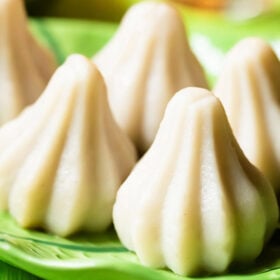
Modak Recipe – Handmade & With Mould
Ingredients
For the dough cover
- 1 cup (150 grams) Rice Flour
- 1.5 cups water
- ¼ teaspoon ghee or oil
- ¼ teaspoon salt
For sweet stuffing
- 1 cup (100 grams) coconut – grated and fresh
- 1 cup (200 grams) jaggery finely chopped or grated; or use jaggery powder
- 1 teaspoon cardamom powder or 6 to 7 green cardamoms, powdered in a mortar-pestle & husks removed
- ¼ teaspoon grated nutmeg or ground nutmeg powder (jaiphal powder), optional
- ½ teaspoon poppy seeds (khus khus), optional
- ½ teaspoon ghee or oil
- 1 tablespoon Rice Flour – optional
Instructions
Making sweet coconut stuffing
- Heat ghee in a pan. Keep heat to a low. Add poppy seeds. Fry for some seconds till the poppy seeds start crackling.
- Then add grated fresh coconut, jaggery, cardamom powder and grated nutmeg.
- Mix well and cook this coconut-jaggery mixture on a low heat. The jaggery will melt first.
- Stirring often cook this mixture for 7 to 9 minutes till the moisture from the jaggery begins to dry. Turn off the heat. Don’t overcook as the jaggery then hardens.
- Keep this coconut-jaggery filling aside to cool. Note that on cooling, this stuffing mixture will thicken more.
- You can also add a bit of rice flour to this mixture. This is an optional step. The rice flour helps to absorb moisture, if any from the filling.
Making rice flour dough
- In a pan add water, oil or ghee and salt. Keep it on the stove top. Let this mixture come to a boil.
- Reduce the heat and add the rice flour gradually. Quickly stir and mix the flour with the water. Stir till all the rice flour is mixed with the water.
- Switch off the heat. Remove the pan from the stove top and then cover this pan with a lid for 4 to 5 minutes.
- Now take all the dough in a large plate or thali or in a bowl. Gather the dough together and begin to knead it.
- The dough will be hot when, you begin to knead. So apply some water on your palms and knead the dough.
- Knead the dough very well. If you feel the dough looks dense or hard or dry, then just add a few teaspoons of warm water and continue to knead.
- Make small balls from the dough. Roll the balls till smooth in your palms. You can also apply some water on your palms, while rolling the balls.
- Keep the balls covered with a kitchen towel. The balls should be smooth in appearance and should not have any cracks.
Shaping modak without mould
- Take a ball and flatten it with your fingers to a round disc or a shallow bowl shape. You can apply ghee or oil in your palms while flattening. Place the sweet filling in the center.
- Flute and press the edges. Bring together all the edges and join them. Remove the extra portion of the dough from the top, if any. Shape and taper the top of the modak with your fingers.
Shaping modak with mould
- Grease the modak mould with a bit of ghee or oil. Then close or lock the mould.
- Put the dough ball inside the mould and press it so that a space is made. Place the sweet stuffing inside.
- Cover the bottom with a small piece of dough. Press and smoothen it sealing the modak.
- Open or unlock the modak mould. Remove the modak gently from the mould. Shape all modaks this way with mould.
- Keep the shaped modak covered with a napkin so that the rice dough does not dry out. Make all the modak this way.
Making steamed modak
- Grease a steamer pan lightly with oil or ghee. Place the shaped modak in the greased pan with some space between them. Cover with a kitchen napkin.
- Take 2 to 2.5 cups water in a pot, pressure cooker or an Instant Pot steel insert. Place a trivet or a rack.
- Heat the water on high flame until begins to boil. For instant pot, use the sauté option and let the water begin to boil.
- The water should be hot or boiling when you place the modak in the large pan. Cover the pan and steam modak for 10 to 15 minutes on a medium-low heat.
- On the Instant Pot, use the steam function on high for steaming and keep the steam vent in venting position so that the steam releases while steaming. Use a stop watch to set the time to 10 or 12 minutes.
- Once the ukadiche modak are steamed, you can drizzle a few teaspoons of ghee on them.
- Note that after steaming, the modak should not feel sticky to touch. If the feel sticky, then steam for a few more minutes.
- Offer the Modak to Bhagwan Ganesha.
Serving & Storage
- Drizzle with homemade ghee before serving. Offer to Bhagwan Ganesha as naivedyam during Ganesh Chaturthi. On regular days, enjoy as a sweet snack or dessert. Tastes best when freshly steamed.
- Refrigerate in an airtight container for 1 to 2 days. Steam or microwave with a few drops of water before serving.
Dassana’s Notes
- Rice Flour: You can use homemade rice flour or packaged rice flour. Ensure it is finely ground and not coarse.
- Jaggery: You can use a block of jaggery or even powdered jaggery.
- Coconut: In place of fresh coconut, you can add frozen grated coconut or desiccated coconut. For desiccated coconut use fine grates or fine shreds.
- Poppy seeds: You can easily skip poppy seeds.
- Dough: Make sure that the dough does not become dry or sticky. If the dough is dry, then add some more water. If it is sticky add some more rice flour.
- Stuffing: Do not overcook the stuffing as this will harden the jaggery. If this happens, then just sprinkle a few tablespoons of hot water in the stuffing mixture and mix very well. The hot water will breakdown the hard consistency of the jaggery and make them soft. You can even sprinkle some water and cook the mixture on low heat until it softens.
- Cracks in the dough: Less water will result in the dough being dry and having cracks. Do not add more oil or ghee than what is mentioned in the recipe as this will result in the dough tearing when you shape it.
- Flattening and Shaping: Do not flatten the dough too thin or too thick. A thin dough will tear while shaping and a thick dough will take more time to cook and will taste doughy and unpleasant.
- Note that the approximate nutritional information is for 1 modak made from this recipe.
Nutrition
Modak recipe from the archives was first published on September 2010.

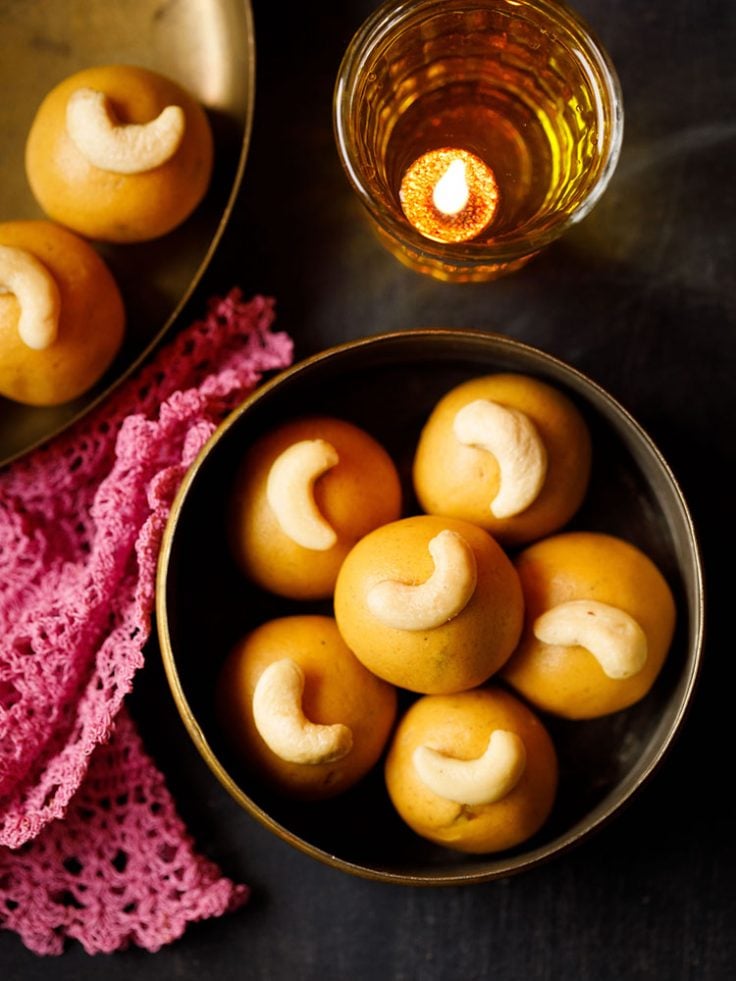
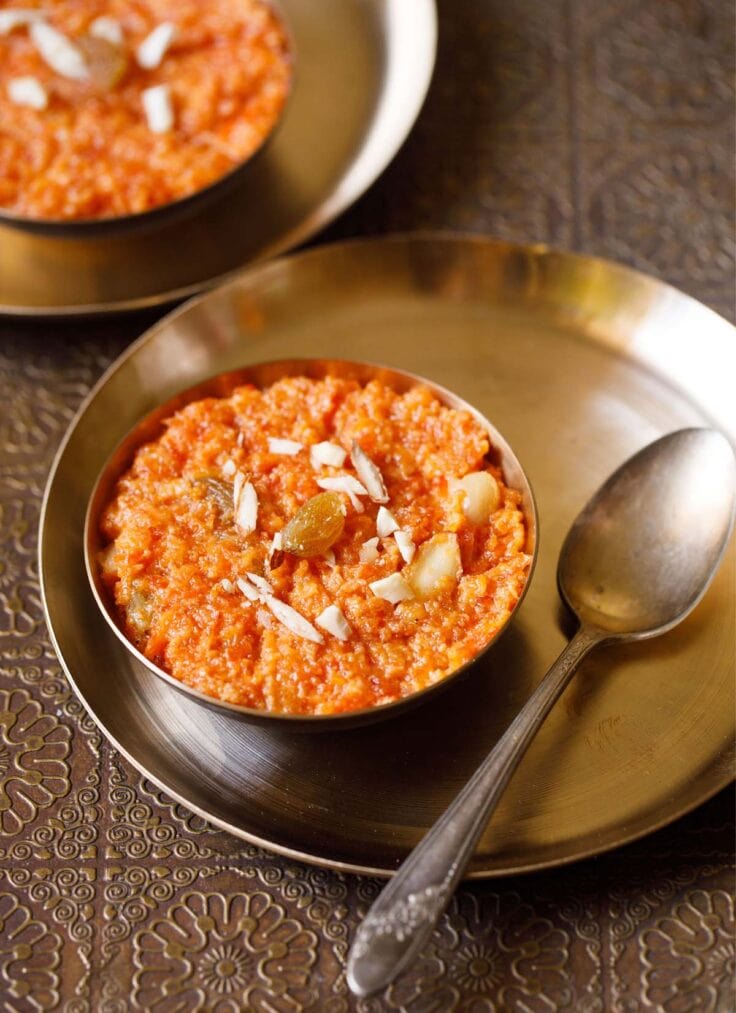
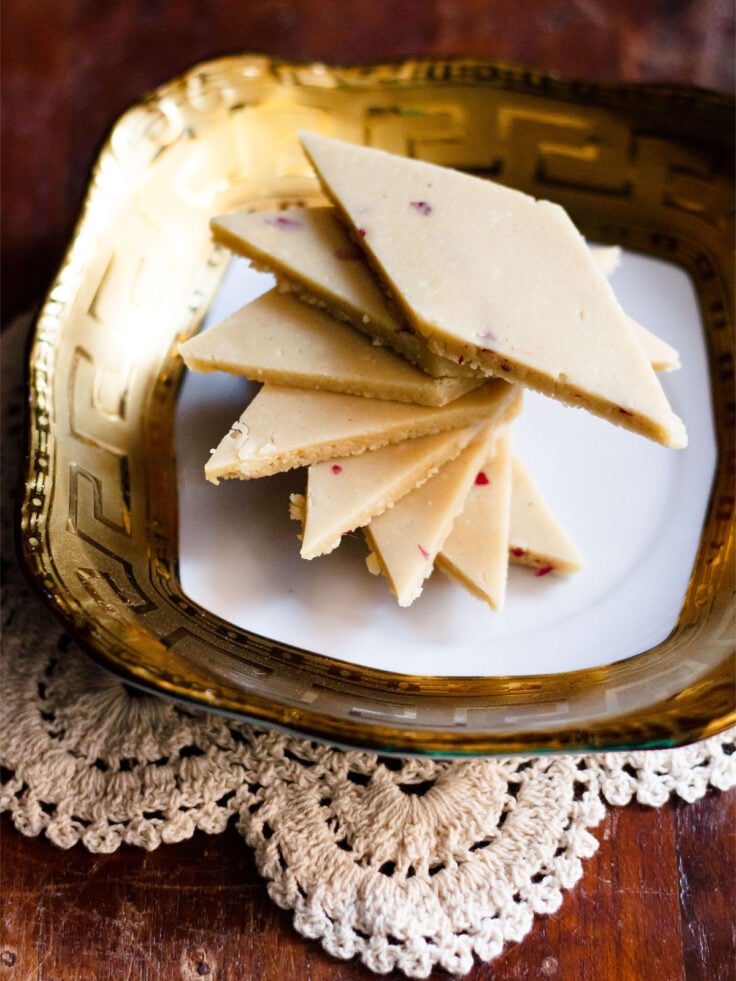
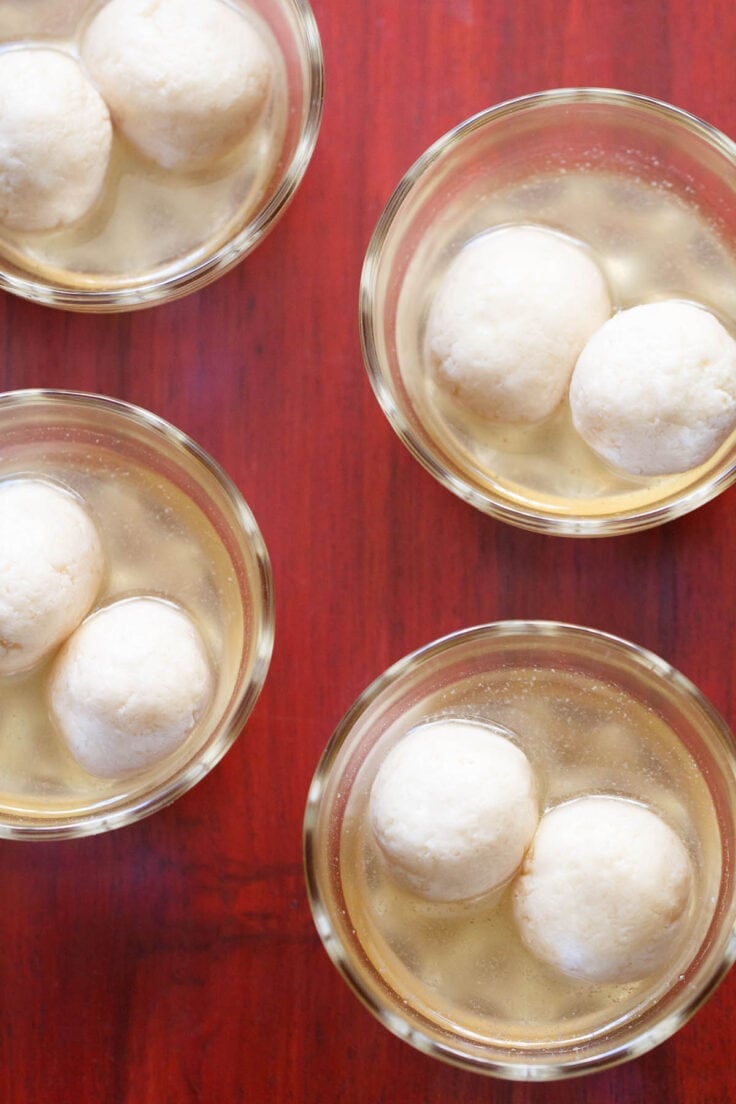
Hi there, I really want to try this recipe this year. I have been told that modak requires a specific kind of rice flour, which is a mix of 3 different grains. Is that true? If so, then are there any alternatives? I do get rice flour locally but not the kind with the specific grains. Is it okay to use the regular white rice flour and is there any thing I should keep in mind specifically while using it?
Not exactly true. Traditionally, ukadiche modak are made with plain rice flour, not a 3-grain mix. You can use regular white rice flour, just make sure it is finely ground and fresh. If it feels coarse, sieve it once.
The key is to add the rice flour to boiling water, mix well, cover and let it steam (with the stovetop flame switched off) for a few minutes before kneading. This makes the dough soft and pliable, which is most important for shaping.
Loved making this recipe. This has now become a must every time during Ganesh Chaturthi at our place.
Wonderful and thanks for letting me know.
Hi Dassana
Can’t stop myself from expressing gratitude for this site
Everything is made with such love !!! Hope one day i can taste sweets you did yourself haha. LOVE
Thanks so much. Hope so!
Your knowledge of Tamil is amazing as always !!!
Thanks!
Hi! You are my go-to person (website :)) for any Veg recipe, and not once have i been disappointed. Tried the modak today for the first time.. except for the jaggery mixture hardening a bit- which i realised i overcooked, it turned out really really good! Thanks so so much!
Thank you Rasika for the feedback and glad to know that the modak was good. If the jaggery mixture hardens you can add sprinkle hot water in it and mix. It will make the jaggery loose the hardness.
Hi Dassana,
Thank you so much. All your recepies are very well explained. From past 7-8 years I have learnt & made so many recipies watching your videos. I learnt making sweets / desserts & my kids love them.
Thanks & lots of love & best wishes dear.
Meenakshi
Hi Meenakshi, thanks a lot for your lovely comment and kind wishes. Felt good to read and I am glad that the videos and the recipes are helpful. Most welcome and wish you all the best.
Never made modak must try it out
My modaks all cracked open while steaming. What could I have done wrong? Could you pls share a tip to prevent this from happening the other time
The modak should not dry out after being shaped and should always be covered with a kitchen towel. If the outer dough becomes dry, then they may crack while steaming. Even the dough should be covered with a lid or a kitchen napkin. I hope this helps.
Excellent way of explaining, specially the foot note. Thank you for not just sharing this wonderful and traditional receipe, but also for your gesture to protect the divinity and culture around making MODAK !
May Bappa always keep the Annapurna within you protected and blessed???
Thank you so much. Touched by your comment and kind wishes. Wish you a Happy Ganesh Chaturthi festival full of peace, abundance and joy.
Your writeup are as lovely as the recipes. Your mentioning not to taste the filling is so apt.
May lord Ganesha bless you.
thank you priya for the kind wishes. wish you a happy ganesh chaturthi festival.
Hi Dassana.. thanks for this recipe and thanks for all ur recipes. I usually follow your site to make food. It has, to some extent, reduced my anxiety of making food every day, which was quite troublesome for me before. I simply love the way you describe the preparation method with the pictures, quantities (which we can adjust as per our needs), the do’s and don’ts. Thank you so much for making life easier. May Lord Ganesha bless you with happiness and joy. 🙂
hi pooja, thank you so much for this lovely feedback and also for your kind wishes. wish you a happy ganesh chaturthi festival and thanks again.
Hi dassana, we tried ukadiche modak but we were unable to shape them properly can you please give more comments on shaping them.
hi akash, it is due to less water in the rice dough. 2 to 3 teaspoons or more warm water can be added in the rice dough and kneaded again. if you see fine cracks while shaping, then just dap the fingers with some water and shape. the cracks will go away. also knead the dough very well. when flattening the dough balls, you can spread a few drops of water on the palms or fingers and then flatten. the shaping method shown here is the easiest. there is another way of shaping modak with many petals (pleats) and it comes only with practice. hope this helps.
Hi dassana,
Is that pic of altar of Lord Ganesha from your home? It’s very beautiful.
no Ruchi. its from the Ganesha pandal in our area ????
Oh well 🙂
Hi dassana… I HV tried this recipe.. It was awesome… Everyone loved it ..
Thank u for such fantastic recipes..
I loved ur website..
All the best… Keep it up
thanks sharvari for sharing this feedback. glad to know. happy ganesh chaturthi festival to you.
HI,
Thanks for sharing this but my coating was not smooth enough enough and kept breaking. Can you help?
some more water could have been added to the outer cover mixture. it would have become smooth.
All your recipes are top class…First time i tried steamed modaks and it turned fine…. No cracking…. Everyone liked it …. Timely for Ganesh puja!….I would have liked the covering to be thinner… Any tips? Thanks for sharing!
thanks a lot brinda. for the covering to be thin, you have to flatten more with the fingers till you get a thin cover. its not difficult but just need more practice and patience.
Hi!! I love steamed modaks. Iv been making them for a while now, but I have no idea how to store them. I wanted to make them a day in advance at least as they are time consuming.
Plz help! Is there any way that I could store them? At least for 24hrs
shannon, store modaks in a casserole or in an air tight steel box. do cover the box tightly. then refrigerate. you can easily keep for 2 to 3 days.
Can we use watermelon seeds instead of poppy seeds? I am going to try it for the first time and want it to come out superb.
Ankita, yes you can use watermelon seeds. If you want then you can skip adding poppy seeds (or watermelon seeds) also.
Hi can I make madak a day before and eat them next them
Monika, yes you can. but if you are making it for lord ganesha then make it fresh and don’t taste it while making. best taste come when eaten fresh.
Wonderful step-by-step recipe! Mentioned this in my blogpost on festival snacks
thanks again subha.
Hi Dassana,
I tried this recipe for steamed modak but my modaks were not cooked properly even after 20 – 25 minutes on low flame in a steamer.
The upper portion was undercooked and rest was fine. Not sure what went wrong . I felt really bad so made fried modak next day and they were perfect
Ritu
ritu, fine. no issues. as we all have cooking mishaps at times. thats how we learn. don’t feel bad. it appears that the rice flour dough was under cooked. as 20 to 25 minutes is a long time to steam modaks. also could be that the upper portion must have had too much of rice dough and must be thick. thats why it was not cooked well. but i am glad that the fried modaks came out good for you. hope you had a lovely ganesh chaturthi festival.
Hello,
I tried this recipe and it came out so well. Modak were tasty and didnt break at all. Sweetness of filling was just about right. I am glad becasue it was my first try and every thing went well. I love all your recipes.
Thanks for sharing 🙂
thanks neha for positive feedback 🙂 glad you liked the modaks, welcome always.
Hii
I have a query,
Can I use dry coconut powder instead of fresh grated coconut? Is it make any difference in steaming?
you can use dry coconut. in steaming does not make any difference. one difference would be that dry coconut+jaggery mixture will take less time to cook than the fresh coconut+jaggery mixture. also the taste of modak will be different when made with dry coconut.
Thanks!! I will try to make
surely try digvijay and do share your views once you make the modaks.
I tried your recipe today and the modaks turned out very well. This was my first time making modaks and I was happy with the results. Thank you so much for sharing this recipe. Have a good day ?
Welcome Namrata. Glad to know that you liked ukadiche modak recipe. Happy cooking.
Hi . I don’t have a special steamer. Just wondering if cooker without the whistle will do? Thanks
R
welcome rakhee. yes it will do.
Hi, I made modaks first time yesterday & the modaks turn out just awesome. Though I made it first time, the modaks didn’t crack at all. The taste was also too good & the sweetness was perfect. Everyone loved it. I am very happy that in first attempt the modaks turn out so good.Thank you so much for sharing this recipe. Your receips are very easy & best to make.
welcome neha, pleased to know this. thanks for your kind, encouraging and motivating words. god bless you.
Thanks a lot for the timely reply.
I will surely try this.
sure roshni do try and let us know how the modaks were? thanks.
Hi,
I have a query.
Can I use brown rice.
Like the same way Mangalore style pundi is made. Using the same batter can I make modaks.
you can use brown rice and use the method of mangalore style pundi. there is another way where instead of making modaks, you can steam the rice batter in a turmeric leaves or banana leaves. you can use ground rice batter or rice flour batter. we call these as patholi. here is a post with step by step pics – https://www.vegrecipesofindia.com/patholi-recipe/
modak gets cracked after one day so how it can be prepared so that it does not cracks.
the rice dough has to be smooth. if there are fine cracks while making the dough bowls, then just apply some water on your palms and the cracks will smoothen up. also keep them stored in a tupper ware or casserole so that the outer cover does not become too dry.
Hi Dassana,
Hope you’re fine. Please tell me which brand of jaggery powder you’ve used in this recipe as I want to try making modak for Ganesh Chaturthi this year.
Thanks & regards,
Neeti
neeti i use organic jaggery powder for modak recipe, hope this information helps you.
MadamJi, I will tell my wife to try modak this Chathurthi….
Amazed to see Date update, Appreciate your Attentiveness which make your blog “THE BEST “
thank a lot shailesh ji. i have updated the date as it will help the readers.
Hi, I am going to make them for first time this year on ganesh chaturthi. Can you please let me know if we can store them in fridge for day or two.
Thanks,
firstly all the best for preparing modaks. yes you can store them in the fridge for a couple of days. place them in an air tight container or you can place them in a casserole. so that the outer cover does not dry out. after refrigeration the outer cover does become dense, so you can let the modaks come to room temperature or sprinkle some water on them and microwave for some seconds.
Respected madam, I made these modak twice. First time the filling was little hard as I cooked it for little longer time. But second time the filling was perfect and the modaks were awesome. But with God Grace and your instructions, though I made them only twice the modaks did not break nor crack while steaming. They were perfect. Nearly 10 people ate them and all of them loved it. Thank you very very much. Ur recipes are simple to prepare and The best.
firstly thank you vijay for your positive feedback 🙂 secondly making modak is an art the more times you make you will master the art. glad to know your folks loved the modak. you are welcome always.
I have never been to Maharashtra, but my friend told me that modaks are really nice. So I am going to give it a try with your awesome detailed recipe. Thanks so much for sharing your recipes with us.
welcome moumita yes modak is a traditional recipe of maharashtra it takes times but worth every bit of effort. surely try and let us know how it was? thankyou
You guys are absolutely amazing and your recipies are so flawless. None of the dishes I tried from here has ever gone wrong. This page is like another mother/ mother in law for me ;-).
Modaks, I thought were the toughest to do ( they may break and ooze out, the shape, thickness could go wrong and all those concerns) but this made it look so simple and was simple and tasty/ presentable in actual too!! Keep adding in more n more recipies.. M so dependent on you guys 🙂 😉 Biiiig Thank you!!
thats sweet and kind of you yamini. thank you much.
I absolutely love this website. The recipes are easy to follow.
thanks leah
This recipe was very helpful:) I will definitely be making this in the near future. I am a budding cook trying out various recipes, any suggestions?
thanka ajay. there are many recipes posted on the blog. using the google search bar on the top, you can easily find the recipes. in fact most of the recipes are easy to prepare.
was very easy to follow the method
thanks manoj
very clearly explained recipe. Inspires me to try making modak.
thanks deepa
Hello Mam
Mam today I tried this recipe for Ganesh Festival ….as I am from Punjab I got Rice flour very hardly here….but problem I faced in making this is…..while making shape my modak base ( Rice with Water ) breaks from little little spaces….I really get depressed as I cooked for Festival… 🙁 plz guide mam
please don’t get depressed mehak. when first time made, there are bound to be problems. making perfect modaks comes from experience. as you make modaks often you will get the knack of making them perfect. the dough has to be soft and smooth and when flattened the round disc should neither be thin nor thick. moreover the consistency of the jaggery-coconut mixture should be correct.
ok Mam,
Thanks for ur reply 🙂 i will sure do practice to make perfect one…actually as I am from punjab I never tasted these rice flour modaks so I was really worried 🙁 but u know what happened ….whn i serve in front on Ganesh Ji then of course it turns into “Bhog” it taste quite good 🙂
actually mehak, modaks tastes very good. so even if the cover is broken here and there, the taste is still good. and what matters the most is the devotion and love that we have while preparing naivdeyam or bhog 🙂
Hello Mam…….u were right ….love make things more tastier and delicious ….n when prepared for Divine it become obvious 🙂 I tried again n this time it was perfect 🙂 thx for ur support 🙂
welcome mehak
thanks dassana for easy and clear recipe.
thanks anjali
Please check this youtube video. We call it as Yomari but it is similar one.
http://www.youtube.com/watch?v=ByOr3FDqx0I
thanks ram for sharing this video. looks like yomari is similar to modak.
Hi Dasana,
I dont know cooking beginner like me this slide will help me a lot i must try at home today thank you so much
meena, as a beginner you might not be able to give perfect shape to modaks. but as far as taste is concerned, feel confident about this recipe and go ahead and make this modak recipe for ganesh chaturthi festival.
HI DASSANA…..the explantaion of modak dish was nice.. i really liked it.. thanks
thanks anusri.
hey Dassana i made modaks yesterday and they turned out to be so good that i was amazed at myself that how could i make so perfect and that too first time..thanks so much for such easy explanation..
thank you suhani. feels so good. it is possible that one can be a novice and yet make perfect dishes the first time 🙂
Thank you for the lovely recipe. I tried it today morning and it turn out so well. Thank you so much, its an encouragement for a beginner like me. A well written step by step recipe.
thanks for your encouraging notes nava 🙂
hey Dassana..i wanted to know that can i use dessicated coconut instead of fresh one..will it bind well with the jaggery..and also can i use puran poli filling recipe of urs in the modak..
hi suhani… you can use dessicated coconut instead of fresh coconut. you can also add sesame seeds if you like, in this mixture. yes, you can use puran poli filling with or without coconut in the modak.
Presented in a nice way, any one who is learning cooking for the first time this website will help u…
thanks saritha for the lovely comments
Nice article and Awesome modak. It is kind of hard to prepare it and buy it outside. At mealnut, we home deliver modak prepared by experts like you. If you want it to be home delivered, order on mealnut.com
Very helpful recipe. Thanks so much for all the photos and details. Really helps a first-timer 🙂 Now I am confident about being able to offer this to Lord Ganesh this year! A Happy Ganesha Chaturthi to you!
happy ganesh chaturthi to you to anu. i hope you make great modaks for lord ganesha.
presented in a nice way. step by step. my modak also break as u mentioned but taste was good.
thanks shalini. sometimes the modaks do break, but the taste is always good.
It’s tasty
thanks for the modak recipe .i always hav problems doing it, now i can do better modaks this year.
thanks
Hey… thanks for the post… In Bengali we call sweet rice does of this kind as “puli pithe” but I never had the idea that modak is also made in the same manner… 😀 thanks a ton… yumms am actually feeling hungry… would ask mom to make once again today itself… 😀
thanks sudeshna for taking out the time to comment on so many posts. i did not know you have a similar sweet in bengali cuisine.
yup we mainly have it during the bengali month of “Chaitra” which is last month of the bengali calender and during that time most of the harvesting is ready…. so its a celebration time… we even have a dish called “pati shapta” mom makes it with suji and rice mixture with water.. make it like small dosa pattern and fill it with khoya (i preffer it with sweet coconut filling) and roll it… these dishes continues till poila baisakh… you can even try making the same dumplings (steamed) and put it into sweet milk.. its called “dudh puli”
thanks for sharing these bengali sweets sudeshna. in konkan/goa there is a similar dish called as “patoli” made with rice flour and stuffed with coconut-jaggery mixture and then steamed in turmeric/haldi leaves. the dudh puli sounds interesting.
after reading your comments yesterday i went through a bengali cookbook which i have. i had got the cookbook some months ago but did not read it all. the book has so many delicious bengali recipes and that too easy to make.in fact i was thinking to make bhappa doi and some more bengali recipes and even putting it on the blog…
Nice Recipe. I prepared it today. My hubby & my son both loved it.
The details & picture both helped me to prepare it in the right way.
Thanxs for a lot.
thanks sunitha. felt good to know that your family loved the modak recipe.
what beautiful and slender fingers and palme more than the modak i have fallen in love with your palm
hey its very nice picture presentation. i clearly understood the preparation of modak with this. thank you
thanks anitha…
Hi,
Happy Anant chaturdarshi to all. Tried “Ukideche Modak and they turned out to be excellent n very tasty prasad….As if Lord Ganesh showered his blessing in terms of the real sweetness in my homemade MODAK. Everyone appreciated in my family too.
Thanks and Regards,
dear harsha, that’s so nice to know.
i am really pleased… i pray that lord ganesha keeps on showering His blessings on you and your family….
Thanks for sharing..
I must do this..
do try the modak recipe, guruprasad…
hi,
Oh! i see lol that was taken with yellow lights!!. The Modakas that I prepared was really nice and came out good. My family like it ..and i am very happy to say that I could prepare this sweet now. Thankyou so much for the explanation and the easy instructions with pics.
Happy cooking and good luck
thats nice to know prerana. happy cooking and good luck to you too…
it is a very good receip.
Thank you very much
Happy Ganesh Chaturthi
thanks malati and happy ganesh chaturthi to you too.
Wishing you Happy Ganesh Chathurti. I loved your recipe and you have explained it in a detailed step by step process.
thank you lalita and wish you too a happy ganesh chaturthi
Hi,
Happy Ganesha festival,
Thankyou very much for the wonderful step by step procedure. Today I did try it…i hope it tastes good after naivedhyam. ..but i have one question. The final modhaka looks still very white instead of golden color like yours…i have pressure cooked it without whistle for 10mins but color is white….please explain about pressure cooking…like do we have to add water at bottom in the cooker and if i add the whistle will it turn golden….yellowish color.
thankyou
prerana
happy ganesha festival to you too prerana.
the modaks look golden yellow as the pics were taken in my living room with yellow lights 🙂
if you carefully observe the other pics, the pics of the modaks taken in the kitchen are white.
the modaks remain white even after cooking.
secondly we need to add water in the pressure cooker for steaming. you could also use idli racks with the idli vessel for steaming the modaks. its exactly like steaming idlis.
if using pressure cooking the whistle/vent weight has to be removed.
i hope that the modaks have turned out well.
My mom does in a heavy bottom kadai.. takes the water in lower level, puts a smaller dish into that and then cover that with a big thali and puts a heavy weight on that… 🙂
thanks sudeshna for sharing the method which your mom uses.
thank you for the step by step pictures and for the clear and easy directions to make these modaks. Happy Ganesha Chaturthi -May the Divine bless you and grace you abundantly always.
thanks rsn. may the divine shower blessings on you too…
Hiii,being a malvani I like ur recipe .I hv shifted to Malaysia wid my husband so missing Ganesh festival but will try to make modak for sure thanks a lot
thanks shilpa…. do try the modaks…
i love it.. avery nice recipe……….
a well explained step-by-step procedure of modaks.
thanks prachi
I like the recipe of MODAK very much.It is provided with fully satsfying recipe with colourful pictures.I WILL TRY TO MAKE MODAKS AT MY HOME.
A nice recipe.This sweet dish enjoyed by all family members.Thanks.
A nice recipe. Modak prepared twice its ok and satisfied.
Happy Ganesh Chaturthi!
I hope this dish really enjoy our Lord Ganesha!
The way you are taking care and especially Wonder Love and devotion while preparing.
I do remember this while prepare.
Thanks a lot.
God bless you.
same to you and I pray that Lord Ganesha bestows peace and prosperity in your life. Thanks for the appreciation. God bless you too.